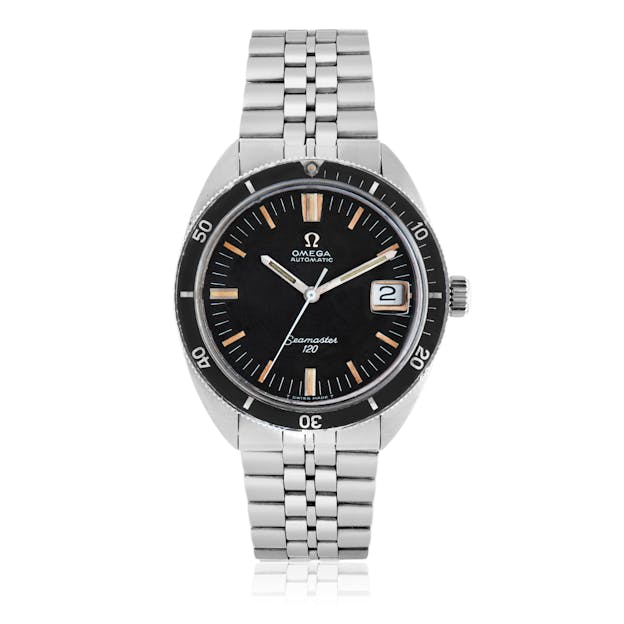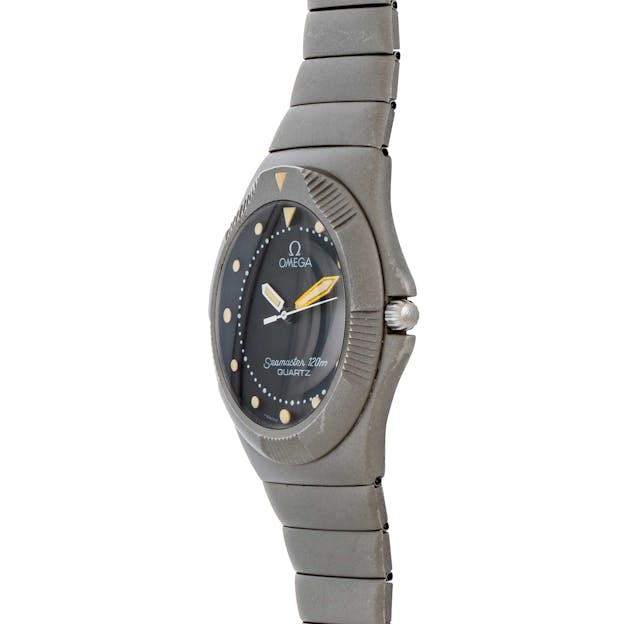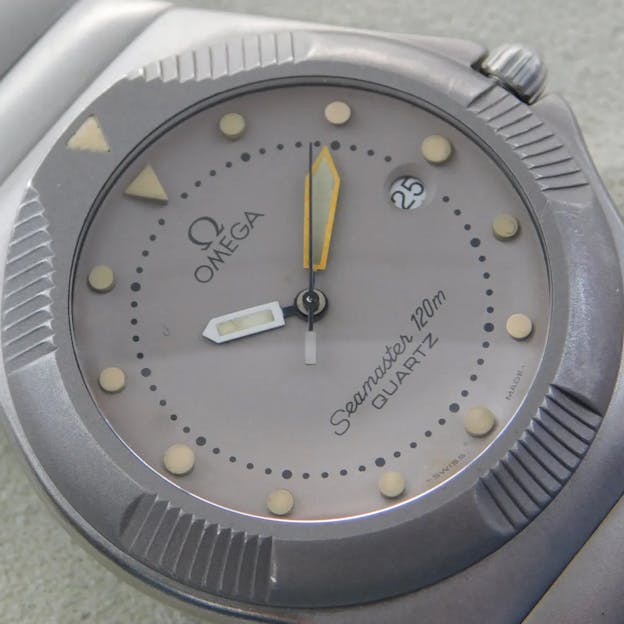Lost In Time: The Omega Seamaster 120 ‘Recife’ Is A Forgotten Gem Of The Quartz Crisis
A story of design and hope. A one-year wonder, a hidden grail, and a reminder that watchmaking’s past still holds the key to its future.
The quartz crisis tends to get a bad rap. Look, I get it. When your entire livelihood—sometimes centuries in the making—is obliterated in a few short years by a tiny battery, it’s easy to be bitter. If your life revolved around mechanical mastery, only to watch it be made obsolete overnight, you’d probably feel the same way.
But as someone born long after the purists and “old guard” had swallowed their pride, I think it’s worth looking back on that era with some reverence. Because when we step back and take in the watch world today, this little niche of culture, this wearable art, this last stronghold of ancient craftsmanship, we can clearly see what’s been lost.

Today we watch as great pioneers, craftsmen, the last of their kind, slowly pass away, leaving us nothing but stories and dusty old machines, taking their expertise with them. We see how commercialized watches have become, to the point where the sheer oversaturation makes your eyes bleed from doom-scrolling. Does the popularity take away from how they made you feel when you opened the box of your first luxury watch?
We see today, the relentless algorithm that bombards you with more and more—marketing dressed as meaning, content engineered to extract dollars rather than admiration, understanding, or connection. Another press trip, to wine and dine, why not… to coddle you into a place of security so you say all the nice things, like an ex trying to get back in your good graces. It’s enough to make you gasp for air, desperate for meaning in a materialistic world.

But when you look back at the quartz crisis, you realize something: they weren’t in crisis over meaning, like we are today. They weren’t in a lull of creativity, like we are today. When the industry pivoted away from mechanical complications—when slow, labor-intensive feats of micro-engineering no longer separated one watch from the next—brands got creative. If the movement alone couldn’t distinguish a watch, then the design had to.
So, sure, we can thumb our noses at quartz watches. Many do. But I refuse—on one condition. That watch brings something to the table. It has to say something. It has to be original. I’m on a hunt for meaning again, and I’ll dive deeper into that philosophy in another article. But for now, what excites me is finding those little gems—odes to horological history that don’t just tell a story but exude panache, creativity. I want to be excited again. Enough with the minimalism that’s draining the soul out of design. Bring back opulence. By god, take my eyes, but not my shirt.
And now, if you’ve survived that long-winded preamble and exercise in mental vomit, let’s get to the point. The Omega Seamaster 120 Recife.
The Omega Seamaster 120 Recife

One of my grails. A long-lost beacon of the quartz crisis. A hidden, actually scarce gem with shockingly little information available online. And this … this right here, is what I freaking love about watches. I love when you stumble upon something like this (which I did about ten years ago) and just can’t shake it from your mind. Something objectively cool. Something that, the more you learn about it, the more it makes you tingle all over (get your head out of the gutter).
The story of the Omega Seamaster 120 begins in 1966 as an alternative to the Seamaster 300, offering a slimmer case profile while maintaining more-than-adequate water resistance.
Essentially, the Seamaster 120 was what we’d now call a skin-diver. It’s relatively affordable on the pre-owned market, not particularly sought after, and, in my opinion, vastly overlooked when it comes to vintage Omega.

A few years ago, Ben Hodges of Fratello wrote a great piece—a letter to Omega—urging them to bring it back. Will they? Probably not. But I agree with Ben: this is a small gap in Omega’s lineup that, for some reason, they haven’t revisited. Not that every brand needs to resurrect every past model and shove “vintage charm, modern dependability” down our throats, but still—it’s a cool watch. And before you say it: Yes, I’m well aware of the Aqua Terra 150. But it ain’t this. And I’ll leave it at that.
The Seamaster 120 remained a staple in Omega’s catalog until 2003, when it was retired in favor of the Aqua Terra line. Between 1966 and 2003, it came in so many variations that listing them all here would be impractical. However, in 1984, Omega pivoted and released the Recife—named after the Portuguese word for “reef.”
The Design

This watch is quintessential ’80s modern—if that’s even a thing in 2025. One look at it, and you feel like you’re in Knight Rider or watching a MacGyver villain plot something nefarious. It’s the kind of watch a background character in an early Terminator film might wear or something a nerdy dad would rock in a short-lived ’80s sitcom while helping his kid build a baking soda volcano in the garage—laugh tracks and all.
The first thing you’ll notice? The integrated bracelet, made from oxidized steel. I’ll be honest, I’ve never seen one in the wild, and I’ll explain why shortly. But from everything I’ve found online, the oxidized steel almost looks like titanium. The bracelet design gives off serious Porsche Design Ocean 2000 vibes and reminds me of the Omega Lobster bracelet seen on the Speedmaster, a watch I covered in my non-moonwatch writeup.
Omega describes the finish as “anodic oxidation,” a surface treatment that enhances corrosion resistance, which is understandable for a “dive watch.” This process is similar to anodizing aluminum, where a metal component is submerged in an electrolytic solution and subjected to an electric current, forming a protective oxide layer. This oxide coating acts as a barrier against further corrosion.
For anodic oxidation to be effective, the steel used must be austenitic stainless steel, a category that includes 316L and 904L stainless steel—both considered marine-grade alloys with excellent corrosion resistance. These steels are also largely non-magnetic. Making this watch even more collectible, anodic oxidation is rarely seen in watchmaking. A quick search for oxidized steel watch cases turns up almost no results, with the Omega Seamaster 120 Recife standing out as one of the only known examples. Pretty dope if you ask me.

At 38mm in diameter and just 8mm thick, the Recife lands squarely in the “Goldilocks” zone, essentially the perfect size for any wrist. Then there’s the scalloped bezel, taking design cues straight from the ocean. Finishing out the design Omega borrowed the iconic hands from the Ploprof, and filled the dot hour markers with tritium. Powering the watch was Omega’s quartz calibre 1430, the same movement used in other Seamasters and Constellations of the era.
The Rarity

When you look at this watch, you might catch a few Calypso vibes. But what makes the Recife so collectible—so forgotten, so lost in the annals of horological history, is that it was only produced for a single year. According to Omega, production started in late 1984 and ran through the end of 1985, so I’m rounding it to just one year. You’ll see some listings with “1984” on them, but the reality is, there was no before, and there was no after. The Recife was a one-year wonder. And that’s exactly why, despite my general anti-grail stance, I actually consider this a grail piece.

From everything I’ve been able to dig up, fewer than 1,000 (according to some internet sleuthing into the questionable doldrums of Reddit — like I said, there really isn’t much out there on these watches) of these were ever made, available in either a grey or black dial. The grey, in my opinion, is the one to have—but also the rarer of the two. In all my years of searching, I’ve only ever seen one for sale.
We Are Going To Be Okay
As we gear up for another year of watch shows, and as Watches & Wonders gets us excited for something new, only to leave us generally disappointed (with a few exceptions, like a bad meal that still has a couple of tasty bites)—I implore you to look back in awe of creativity in order to look forward. Get excited by design. Watches should be fun, not just a way of flexing wealth.
Maybe it’s the eternal optimist I pretend to be, but thinking about this watch gives me hope. It’s a reminder that even in times of uncertainty, even in moments where the industry feels like it’s in a creative lull, there are still gems, still breakthroughs.
So here’s to being different. Here’s to the weird, the forgotten, the overlooked. Here’s to the watches that break the mold, the ones that take risks, the ones that don’t care if they fit into a marketing deck. Here’s to the Recife, and here’s to whatever future oddball is waiting to be discovered.
A special thanks to James Lamdin and the team over at Analog:Shift who supported this article with their images, including the header. Collaboration is what makes this community so incredible.

